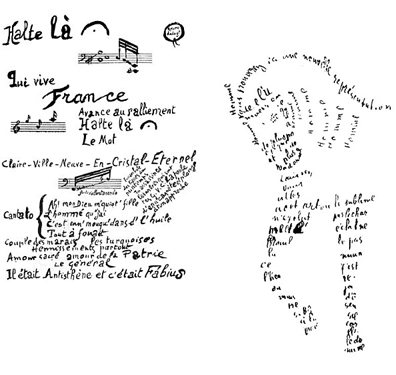During the past week or so, we’ve been looking at poems and aspects of presenting poems on the page which take into account (2-D) visual space and make room for illustration and elements of painting, drawing, collage, etc. This Friday, our prompt asks you to reexamine a form which many of us may remember being introduced to in grade school: the concrete poem.

“Concrete poetry,” according the Poetry Foundation’s glossary, is “Verse that emphasizes nonlinguistic elements in its meaning, such as a typeface that creates a visual image of the topic.” Far from being limited to poems whose words take on the outline of the object they are describing, concrete poetry can encompass everything from a playing with the sizes and spacing of text on the page to certain kinds of full-on “visual poetry,” which are more akin to collage or painting in their methods of arrangement words. The challenge, of course, is how to integrate the visual into a poem in a way that is satisfyingly beautiful (or jarring, depending on the desired effect) and yet feels organic and further enhances the complexity of the reader’s interaction with it.
Prompt: Write a poem takes into account shape and visual space on the flat plane of the page.
Some suggestions:
1) Compose a calligram, or poem in which the shape of the words enacts or take on the visual form of some object as a kind of complex illustration. (See examples of Guillaume Apollinare’s famous calligrams at the top of this post).
2) Create a poem that experiments with unusual typographical arrangements to emphasize its meaning. The Poetry Foundation also has a couple of neat visual poems that play with the shapes of letters: here, and here.
3) Write a poem on a piece of paper (or other flat surface) that is not a standard vertical letter-sized or notebook-sized sheet, using the shape of the surface to guide your form. For example, a long piece of ribbon, or the back of a circular coaster. I’ve found that this exercise (which I’ve borrowed from a former teacher of mine, Bruce Snider) becomes especially interesting if one uses a writing surface that already has words on it and allows those words to seamlessly flow into the resulting poem. (Examples of poets who’ve used a similar technique include A.R. Ammons, who wrote “Sphere” on ticker tape, and D.A. Powell, who wrote one of his books with his notebook turned sideways).
4) Write a poem that engages with the use of negative space in an existing piece of text or image (for example, a poem written in the margins of a newspaper, between the lines of a letter, or in the background spaces of a photograph or advertisement).
We realize that this week’s prompt is a little different, in that your response may or may not be easy to share in comment form. In light of this, we’ve created a Flickr pool where you can upload photos of your responses to our prompts if you’d like to share them [if you don’t feel comfortable uploading photos of whole poems, feel free to crop creatively or blur out portions of the text]. Here’s how to do it:
1) Follow this link to get to our pool.
2) Click “Join this Group.” (Sign into Yahoo/Flickr if you need to do so, or create an account).
3) Confirm that you want to “Join this Group.”
4) Upload the image or video you want to your stream. In the description, mention the prompt you’re responding to (if you like you can include the text, too, but that’s not necessary). We suggest that you tag your poem for ease of navigation as the pool grows (for example, I’ve tagged the concrete poem I uploaded with “concrete poem”), but that’s also optional.
5) Choose “Groups >> Your Groups”
6) Select the group “Lantern Review — Weekly Prompt Responses”
7) Click “Add something.” Follow the instructions to add your photo to the pool. That’s it!
We hope that you’ll share some of what you’ve written with us; we’d love to see how your experiments turn out. If we get enough responses, we may even feature some of them on the blog in upcoming weeks.